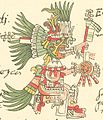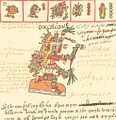Aztecs


The Aztecs were Native American people who lived in Mesoamerica. They ruled the Aztec Empire from the 14th century to the 16th century.[1]
The name "Aztec" comes from the phrase "people from Aztlan". Legends say that Aztlan was the first place the Aztecs ever lived. "Aztlan" means "place of the herons" in the Nahuatl language.[2]p. 8
Often the term "Aztec" refers just to the people of Tenochtitlan. This was a city on an island in Lake Texcoco. These people called themselves the Mexica which is why the country is called Mexico, or the Nahua which is why their language is called Nahuatl.[3]
History[change | change source]
Before the Aztec Empire conquered them, the indigenous (native) people lived in many separate city-states. These were small cities with farmland around them. Each state had its own ruler. Around 1100 AD, these city-states started to fight each other for power and control of the area's resources.[4]
Historians think the Aztecs came to central Mesoamerica around 1200.[5] They came from what is now northwest Mexico. According to historian Lisa Marty:
| “ | When the "Mexica" arrived sometime in the 1200s A.D. in Central [Mesoamerica], they were [seen] as crude barbarians. Wearing animal skins and living as hunter-gatherers[,] their lifestyle clashed with the settled agrarian [farm-based] communities of the area. At first, they lived as wanderers eating snakes and vermin ... For about 100 years, the Aztecs lived like outcasts wandering in the Central Valley. Thrown out of one territory after another, they were forced to eke out an existence in a place where no one else wanted to live: on a group of small, swampy islands in the middle of ... Lake Texcoco[.] [6] | ” |
By 1325, the Aztecs had built Tenochtitlan on an island in Lake Texcoco. Tenochtitlan became a city-state that gradually became more and more powerful.[6]
By about 1400, three city-states had grown into small empires. In 1428, these two empires fought the Tepanec War for control of the area. The Texcoco empire made an alliance with some other powerful city-states, including Tenochtitlan, and won the war. These allies were supposed to share power equally as they started to gain control of more land. However, by 1430, Tenochtitlan became the most powerful member of the alliance. It became the capital city of the Aztec Empire, and its ruler became the 'high king' of the Empire.[7]
-
Aztec drawing of the Mexica leaving Aztlan
-
Map of Mesoamerica
-
Map of city-states in the 16th century
The Aztec Empire[change | change source]

The Aztec Empire existed between about 1438 AD and 1521 AD.[5] When the Empire was largest, it spread across most of Mesoamerica and controlled about 11,000,000 people.[8]
Tenochtitlan[change | change source]
Tenochtitlan was the capital city of the Aztec Empire. Tenochtitlan was one of the greatest cities of the world in that time. By the early 1500s, at least 200,000 people lived in the city. This made Tenochtitlan the largest city in the Americas before Christopher Columbus arrived.[9]
Mexico City now covers the whole area where Tenochtitlan used to be.[10]
Religion[change | change source]
The Aztecs believed in many gods. Two of the most important gods they worshipped were Huitzilopochtli, the god of war and the sun, and Tlaloc, the rain god.[11] Another important god was Quetzalcoatl (feathered snake), the god of learning and civilization.[12]
The Aztecs did many things to keep the gods happy. These things included human sacrifices.[13] They believed this helped keep the world from ending.[11] The Aztecs believed that the gods had created them, and that human sacrifice was the most powerful way of giving back the gift of life. The Aztecs also believed that the gods were in an almost never-ending struggle. The hearts and blood from the sacrifice fed the good gods to give them strength to fight the evil gods. The human sacrifices often took place on the Templo Mayor, the Aztecs' great pyramid temple.[11][14]
-
Huitzilopochtli, as depicted in the Codex Telleriano-Remensis
-
Quetzalcoatl in the Codex Telleriano-Remensis
-
Tezcatlipoca in the Codex Borgia
-
Spanish drawing of a human sacrifice
Food[change | change source]
The Aztecs ate plants and vegetables that could grow easily in Mesoamerica. The main foods in the Aztec diet were maize, beans, and squash. They often used tomatoes and chili as spices.[15] Aztec markets sold fruit, vegetables, spices, flowers, dogs, birds, and cocoa beans. They also created chocolate. However, they did not have sugar, so their chocolate was a strong liquid with chili in it.[16] They also made an alcoholic drink called chocolatl.[17] These foods later spread around the world.[16]
Social structure[change | change source]
In Aztec society, there were different social classes with different social statuses. The most important people were the rulers.[8] The Aztecs' first king was Acamapichtli.[18] Their last king was Cuauhtemoc. He surrendered control of the Aztec Empire to Hernan Cortes during the Spanish conquest of the Aztec Empire.[19]
Next were nobles. These were the Empire's powerful members of the government; great warriors; judges; and priests.[8] These people enjoyed a high social status.[20]
The next social class was the commoners (common people). These were the Empire's everyday workers. Most of them farmed, ran stores, or traded. Other workers included artisans, regular soldiers, and fishers. Commoners were allowed to own land as a group or a family. However, a single person was not allowed to own land.[20]
The lowest social classes in Aztec society were serfs and then slaves. Slaves had no rights at all. They were bought and sold at Aztec markets.[9] The Aztecs also sacrificed some prisoners of war to their gods.[21] However, if they had the money, they could buy their own freedom and become commoners.[20]
For most of the Aztec Empire's existence, it was very difficult to move between social classes. Usually, if a person was born in a social class, they would stay in that class for the rest of their life.[8]
Aztecs had harsh punishments for crimes that seem simple to us now. For example, a person could get the death penalty for adultery; cutting down a living tree; moving the boundary of a field to make their land bigger and someone else's smaller; major theft; treason; disorderly conduct (causing trouble in public), drunkenness; and promiscuity. Under Aztec sumptuary law, a commoner could also get the death penalty for wearing cotton.[2][20]p. 88
-
Aztec 'high lords', who were in the top social class
-
Merchants, members of "the commoners," carry things they want to sell a long way away
Education[change | change source]
The Aztecs studied astrology and used the movements of the planets and the stars to create different calendars.[22] They had an accurate calendar which consisted of 365 days, based on the movements of the sun. They also had a religious calendar which was made up of 260 days.[23]
The Aztecs also studied and taught many complex subjects, including geometry, mathematics, debate, law, music, poetry, architecture, and agriculture.[24]
Sports[change | change source]
The most popular Aztec sport was Tlachtili. They played this game using rubber balls and vertical hoops on opposite walls in the middle of the court. The game's goal was to shoot the ball into the hoop using their knees. The first team to score won the game.[25]
End of the Aztec Empire[change | change source]
Between 1519 and 1521, the Spanish conquistador, Hernán Cortés, allied with Tlaxcala and other enemies of the Aztecs. The conquistadors defeated the Aztecs, took their empire, and made it into a Spanish colony. Some Aztecs did not want to fight against the soldiers of Cortés, because they thought they were gods.[26]
Aztecs today[change | change source]
Today many Mexican people have Aztec and other Native American forefathers. People still use Aztec symbols in Mexico. On the Mexican flag, there is a picture of an eagle on a cactus with a snake in its mouth. This was an Aztec symbol.[27] Even the name Mexico is an Aztec word.[28]
References[change | change source]
- ↑ Berdan, Frances (1982). "The Aztecs of Central Mexico: An Imperial Society." Case Studies in Cultural Anthropology. New York: Holt, Rinehart & Winston. ISBN 0-03-055736-4.
- ↑ 2.0 2.1 Somervill, Barbara A. (2009). Great Empires of the Past: Empire of the Aztecs. Infobase Publishing. ISBN 978-1604131499.
- ↑ Hansen, Valerie; & Curtis, Kenneth R. (2015). Voyages in World History, Volume I. Centgage Learning. p. 326. ISBN 978-1305537712.
- ↑ Ferguson, William M. (2001). Mesoamerica's ancient cities : aerial views of pre-Columbian ruins in Mexico, Guatemala, Belize, and Honduras (Rev. ed.). Albuquerque: University of New Mexico Press. ISBN 0-8263-2800-8. OCLC 46918564.
- ↑ 5.0 5.1 Trumbauer, Lisa (2005). The Aztec World. Benchmark Education Company. p. 20. ISBN 978-1410846181.
- ↑ 6.0 6.1 Marty, Lisa (2006). Ancient Aztecs. Lorenz Educational Press. p. 9. ISBN 978-0787783259.
- ↑ Chazan, Michael (October 5, 2015). World Prehistory and Archaeology: Pathways Through Time. Routledge. p. 363. ISBN 978-1317347514.
- ↑ 8.0 8.1 8.2 8.3 Cartwright, Mark (November 23, 2015). "Aztec Society". Ancient History Encyclopedia. Ancient History Encyclopedia Limited. Retrieved April 17, 2016.
- ↑ 9.0 9.1 Fagan, Brian; Durrani, Nadia (2015). People of the Earth: An Introduction to World Prehistory. Routledge. p. 443-447. ISBN 978-1317346821.
- ↑ Evans, Susan Toby (2005). "The Aztec Palace Under Spanish Rule." In The Postclassic to Spanish-Era Transition in Mesoamerica. pp. 13-40. Susan Kepecs & Rani T. Alexander (Eds.) ISBN 978-0826337399.
- ↑ 11.0 11.1 11.2 Cartwright, Mark (February 26, 2014). "Aztec Civilization". Ancient History Encyclopedia. Ancient History Encyclopedia Limited. Retrieved April 17, 2016.
- ↑ "The Aztecs/Mexicas". The American Indian Heritage Foundation. 2015. Retrieved April 17, 2016.
- ↑ Carrasco, David 1999. City of Sacrifice: The Aztec Empire and the Role of Violence in Civilization. Boston, MA: Beacon Press. ISBN 0-8070-4642-6
- ↑ Marder, William (2005). Paul Tice (ed.). Indians in the Americas. Book Tree. p. 16-17. ISBN 978-1585091041.
- ↑ Ortiz de Montellano, Bernard R. (1990). Aztec Medicine, Health and Nutrition. New Brunswick: Rutgers University Press. p. 100. ISBN 0-8135-1562-9.
- ↑ 16.0 16.1 Dwyer, Helen; & Stout, Mary (2012). Aztec History and Culture. The Rosen Publishing Group. p. 33. ISBN 978-1433974120.
- ↑ Szogyi, Alex (1997). Chocolate: Food of the Gods. Greenwood Publishing Group. p. 199. ISBN 978-0313305061.
- ↑ "Ask History: What Happened to the Aztecs?". The History Channel. A&E Television Networks, LLC. 2009. Retrieved May 18, 2016.
- ↑ Macdonald, Fiona (2009). The Aztec and Mayan Worlds. The Rosen Publishing Group. p. 60. ISBN 978-1435851702.
- ↑ 20.0 20.1 20.2 20.3 "Aztec Indians". Tribal Directory. Retrieved April 17, 2016.
- ↑ van Teurenhout, Dirk R. (2005). The Aztecs: New Perspectives. ABC-CLIO. p. 157. ISBN 978-1576079218.
- ↑ "Keeping Time". Explore Mesolore. Prolarti Enterprise, LLC and Brown University. Retrieved April 17, 2016.
- ↑ Jimenez, Randall C.; & Graeber, Richard B. 2001. The Aztec Calendar Handbook. Aztec Calendar Handbook. p. 40. ISBN 978-0966116311.
- ↑ Seaman, Rebecca M. (August 27, 2013). Conflict in the Early Americas: An Encyclopedia of the Spanish Empire's Aztec, Incan, and Mayan Conquests. ABC-CLIO. p. 127-128. ISBN 978-1598847772.
- ↑ Vernon L. Scarborough; David R. Wilcox (1991). The Mesoamerican ballgame. Tucson: University of Arizona Press. ISBN 0-8165-1180-2. OCLC 22765562.
- ↑ Lockhart, James; & Schwartz, Stuart (1983). Early Latin America: A History of Colonial Spanish America and Brazil. New York: Cambridge University Press. p. 80. ISBN 978-0521299299.
- ↑ "Mexican Flag". The Price of Freedom: Americans at War. Smithsonian National Museum of American History. Retrieved May 18, 2016.
- ↑ Aguilar-Moreno, Manuel (2007). Handbook to Life in the Aztec World. Oxford University Press. p. 288. ISBN 978-0195330830.









